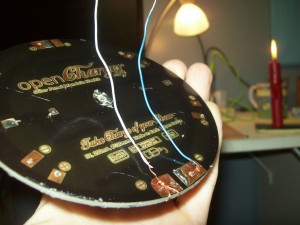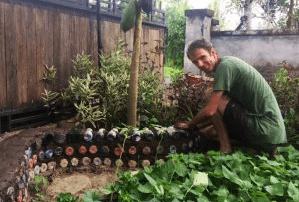Its a really simple innovation, but I am excited about it. Its easy to overlook the amount of energy that has to go into making something. Coming up with ways to make things with less energy and without specialized equipement means making is open to way more people. When people can make their own things, not only do they have ownership and pride in it, the process raises ones consciousness.
So… You can now simply weave or screw on wires to the OpenCharger solar panels! Working on the OpenCharger design back in the villages of Mt. Province, I got a glimpse of how much energy and specialization went into making electronics. To even connect a few wires to a solar panel required a soldering gun, solder and skills. And of course the gun required15 watts of power from an AC 120V plug! How sustainble is that? Let’s also not forget all the noxious fumes that swirl up as one solders away.
And thus began my quest to develop a non-solder, no-energy solution to attaching wires to a solar panel. At first it seemed simple… screw down connectors have been used for such a purpose for a long time. However, two tries with screwdown connectors failed. First the connectors add precious vertical width to the panel. This adds to shipping costs and increase packing and casing volume. Worse, the tension of the screw was invitably breaking the wires that were screwed on. My colleagues hated the design. Back to the drawing board!
I am thus super proud to showcase this simple wire weaving technique. Using a candle and a pin, one can easily perforate the pre-drilled holes on the board. Then, the wire can be woven back and forth and twirled to hold itself down through its own tension. The weaving reliably holds the connection (a drop of carbon solder paint makes it even better) or you can recycle a cell phone screw to hold them down.
 The result is that these panels are now relevant and useable in schools that don’t have electricity or that don’t have science labs (which are precisely the schools and communities that can benefit from them the most!). By simply cutting an old USB cord, weaving it onto the solar panel, one can charge their cellphone! And because this is something that was built by oneself (rather than bought pre-made) the maker is empowered to add to it, to innovate, to make it better, to learn. And then because the one panel will fit together with other panels… well… a whole world of empowered possibilities are now open!
The result is that these panels are now relevant and useable in schools that don’t have electricity or that don’t have science labs (which are precisely the schools and communities that can benefit from them the most!). By simply cutting an old USB cord, weaving it onto the solar panel, one can charge their cellphone! And because this is something that was built by oneself (rather than bought pre-made) the maker is empowered to add to it, to innovate, to make it better, to learn. And then because the one panel will fit together with other panels… well… a whole world of empowered possibilities are now open!


